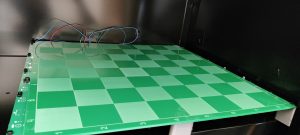This week, I worked on finishing up the mechanical parts of the board. I laser cut some acrylic and engraved it with a chess board pattern that matches out sensor layout on the PCB. Also as part of the board mechanical work, I modeled a very simple magnet holder for the bottom of the pieces.
As part of testing, I tried to quantify the power use of the board. We know the rough power usage of the Raspberry Pi, so in order to verify that our battery capacity is long enough for 10 hours of use, we needed to know the power use of all components aside from the Pi. To last 10 hours, the entire system will need a little over 10.5 Ah of capacity. Our board can fit up to 24 Ah of batteries, so we have more than enough battery capacity.
Progress is still a bit behind in terms of the testing plan, but some tests like accuracy and power have been done. Many of the other tests rely on software integration with the firmware, and since these aspects of the project are behind, the testing is also behind. We will be using our slack time in the next week or two to finalize everything. We also will parallelize as much as possible.
For the next week, I hope to have all the piece and magnet assemblies done as well as have the acrylic attached to the board.

